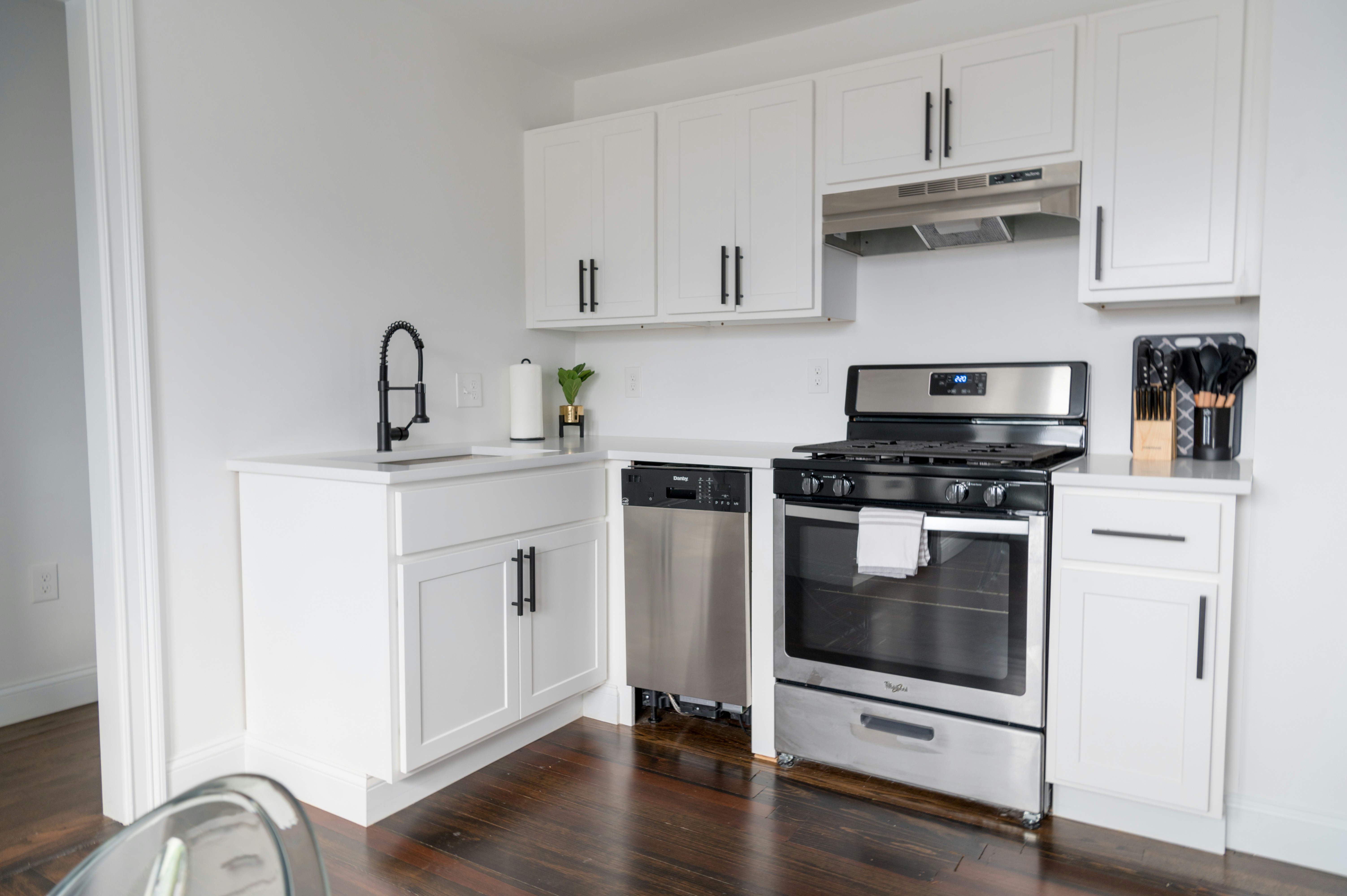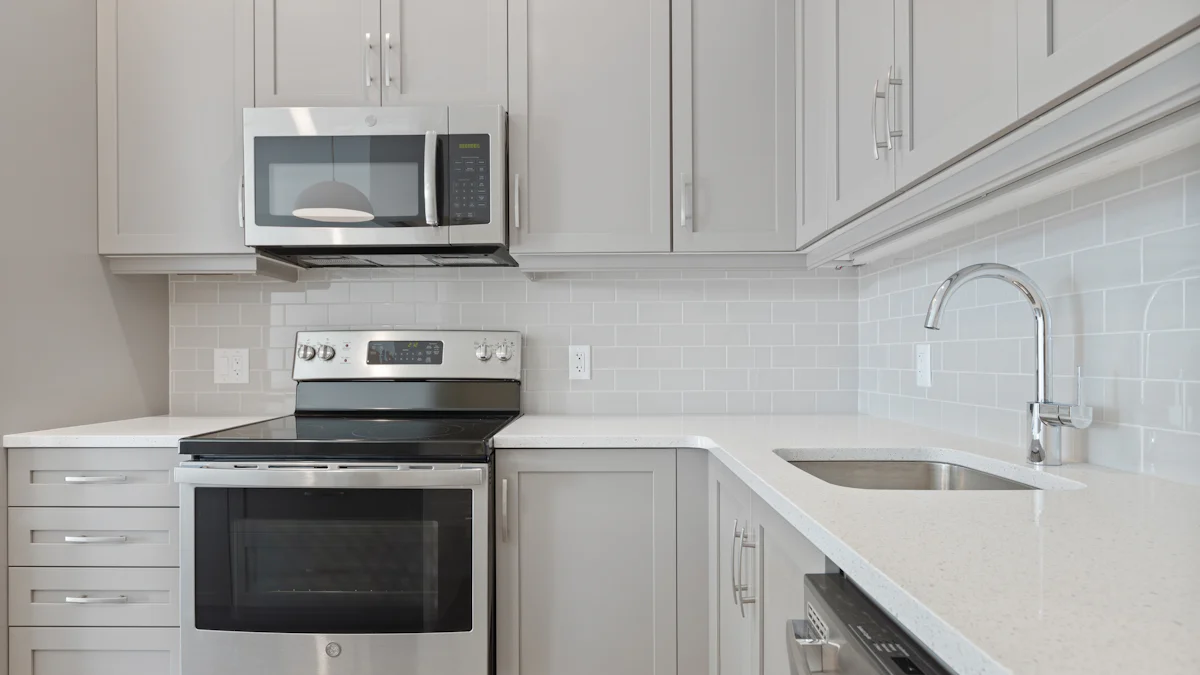Top Tips for Your Freestanding Electric Range Cooker

Maintaining your oven is crucial for both safety and efficiency. A well-maintained freestanding electric range cooker not only ensures optimal performance but also extends its lifespan. Regular maintenance prevents unexpected failures and costly repairs. By keeping your oven clean and in good working order, you enhance its reliability and productivity. Regular checks on burners or elements can prevent issues like improper heating or dangerous emissions. Prioritize routine cleaning to maintain a safe cooking environment. This proactive approach saves money and enhances the longevity of your appliance.
Key Takeaways
Regular maintenance of your freestanding electric range cooker enhances its performance and extends its lifespan.
Choose the right type of cooker (single vs. double oven, induction vs. radiant cooktops) based on your cooking habits and kitchen space.
Incorporate daily wipe-downs and weekly deep cleaning into your routine to keep your stove in optimal condition.
Inspect seals and heating elements regularly to prevent energy loss and ensure consistent cooking results.
Ensure proper ventilation and conduct electrical safety checks to maintain a safe cooking environment.
Address common issues like uneven heating and faulty temperature controls promptly to avoid further damage.
Know when to call a professional for repairs, especially for persistent electrical issues or unusual odors.
Understanding Your Freestanding Electric Range Cooker
Types of Cookers
Choosing the right cooker for your kitchen involves understanding the different types available. Each type offers unique benefits and features that cater to various cooking needs.
Single Oven vs. Double Oven
A single oven provides a compact solution, ideal for smaller kitchens or those who cook less frequently. It offers simplicity and ease of use, making it perfect for basic cooking tasks. On the other hand, a double oven offers more flexibility. You can cook multiple dishes at different temperatures simultaneously, which is beneficial for large families or those who enjoy hosting gatherings. Consider your cooking habits and kitchen space when deciding between the two.
Induction vs. Radiant Cooktops
Induction cooktops use electromagnetic fields to heat pots and pans directly. This method is energy-efficient and provides precise temperature control. Induction cooktops also heat up quickly, reducing cooking time. In contrast, radiant cooktops use electric coils beneath a glass surface to heat cookware. They are generally more affordable and compatible with all types of cookware. However, they may take longer to heat up compared to induction cooktops. Evaluate your cooking style and budget to determine which cooktop suits you best.
Specific Needs of Different Models
Different models of freestanding electric range cookers come with specific needs and features. Understanding these can help you make an informed decision.
Energy Efficiency Considerations
Energy efficiency is a crucial factor when selecting a cooker. Look for models with high energy ratings to save on electricity bills. Induction cooktops are typically more energy-efficient than radiant ones, as they transfer heat directly to the cookware. Additionally, some models offer eco-friendly features, such as energy-saving modes or timers, which can further reduce energy consumption.
Features and Functions to Be Aware Of
Modern range cookers come equipped with a variety of features designed to enhance your cooking experience. Some models offer programmable timers, self-cleaning functions, and multiple cooking modes. These features can simplify meal preparation and maintenance. Additionally, consider the flexibility of installation. Freestanding models can be placed anywhere in the kitchen, providing versatility if you plan to rearrange your space or move homes. Prioritize the features that align with your cooking preferences and lifestyle to maximize the benefits of your freestanding electric range cooker.
Daily and Routine Cleaning Tips for Electric Stove Care

Keeping your electric stove in top condition requires consistent care and attention. By following these cleaning tips, you can ensure your appliance remains efficient and safe.
Safe Cleaning Practices
To maintain your stove's appearance and functionality, use the right cleaning products and techniques.
Recommended Cleaning Products
For effective cleaning, consider using natural solutions like white vinegar and baking soda. White vinegar works well for removing grime from glass stove tops. You can also mix lemon juice with vinegar in a spray bottle to tackle grease and grime. For stubborn stains, create a paste with baking soda and water. Apply it to the affected area and let it sit for a few minutes before scrubbing gently.
Avoiding Damage to Surfaces
When cleaning, use soft cloths or sponges to prevent scratches. Avoid abrasive cleaners that can damage the surface. Use light, circular motions to remove grease spots or food residue. If necessary, drip soapy water onto sticky stains and let it soak before wiping it away. Always clean the oven when it is cool to avoid burns and potential damage.
Cleaning Frequency
Establishing a routine for cleaning your electric stove ensures it remains in excellent condition.
Daily Wipe-Downs
Incorporate daily wipe-downs into your routine to prevent buildup. After each use, allow the stove to cool, then wipe the surface with a damp cloth. This simple step helps maintain hygiene and prevents stubborn stains from forming.
Weekly Deep Cleaning
Perform a deep cleaning every week to keep your stove in optimal condition. During this process, clean the oven racks and interior surfaces thoroughly. Use mild cleaning solutions to wipe down walls, racks, and the oven door. Regular oven cleaning not only enhances performance but also extends the life of your appliance.
By following these electric stove care tips, you can ensure your appliance remains efficient and safe. Routine cleaning and maintenance are essential for preserving the longevity of your stove. Remember, a clean oven not only looks better but also functions more effectively.
Maintenance Tips and Safety Checks

Proper oven maintenance ensures your freestanding electric range cooker operates efficiently and safely. By following these maintenance tips, you can extend the lifespan of your appliance and maintain its performance.
Regular Maintenance Tasks
Routine maintenance is essential for keeping your appliance in top condition. Here are some tasks you should regularly perform:
Checking and Replacing Seals
The seals on your oven door play a crucial role in maintaining temperature and energy efficiency. Over time, these seals can wear out, leading to heat loss and increased energy consumption. Inspect the seals regularly for any signs of wear or damage. If you notice cracks or gaps, replace them promptly to ensure your oven maintains optimal performance.
Inspecting Heating Elements
Heating elements are vital for the proper functioning of your oven. Regularly inspect these elements for any signs of damage or wear. Look for discoloration or uneven heating, which may indicate a problem. If you detect any issues, consider replacing the heating elements to prevent further damage and ensure consistent cooking results.
Safety Measures
Adhering to safety rules is paramount when maintaining your freestanding electric range cooker. Implement these measures to ensure a safe cooking environment:
Ensuring Proper Ventilation
Proper ventilation is essential for preventing the buildup of harmful fumes and ensuring efficient operation. Make sure your kitchen has adequate ventilation, especially when using the oven for extended periods. Check that the range hood or exhaust fan is functioning correctly and clean any filters regularly to maintain airflow.
Electrical Safety Checks
Electrical safety is a critical aspect of oven maintenance. Regularly inspect the power cord and plug for any signs of wear or damage. Ensure that the appliance is properly grounded to prevent electrical hazards. If you encounter any electrical issues, consult a professional technician to address them safely.
Professional Technician: "Routine checks and maintenance by a professional can detect and address potential issues before they become hazardous, ensuring the safety of your household."
By following these maintenance tips and safety rules, you can keep your freestanding electric range cooker in excellent condition. Regular oven maintenance not only enhances the performance of your appliance but also ensures a safe and efficient cooking experience.
Troubleshooting Common Issues
Even with regular maintenance, your freestanding electric range cooker might encounter some common issues. Understanding these problems and knowing how to address them can save you time and frustration.
Common Problems and Solutions
Uneven Heating
Uneven heating in your oven can lead to poorly cooked meals. This issue often arises from faulty heating elements or a malfunctioning thermostat. To troubleshoot, start by checking the heating elements for any visible damage or discoloration. If they appear worn out, replacing them might solve the problem. Additionally, ensure that the oven racks are positioned correctly, as improper placement can affect heat distribution. If the issue persists, consider recalibrating the thermostat according to the manufacturer's instructions.
Faulty Temperature Controls
If your oven's temperature controls seem off, it can disrupt your cooking process. Begin by verifying that the temperature settings are accurate. Use an oven thermometer to compare the actual temperature with the set temperature. If there's a discrepancy, recalibrate the controls. Sometimes, a simple reset of the oven's electronic control panel can resolve minor glitches. However, if the problem continues, it might indicate a more serious issue with the control board, requiring professional assistance.
When to Call a Professional
While some issues can be resolved with basic troubleshooting, others require expert intervention. Knowing when to call a professional can prevent further damage and ensure your oven operates safely.
Identifying Serious Issues
Certain signs indicate that your oven needs professional attention. If you notice persistent electrical issues, such as frequent tripping of circuit breakers or unusual noises during operation, it's time to consult a technician. Additionally, if the oven emits strange odors or smoke, discontinue use immediately and seek professional help. These symptoms could point to underlying electrical faults or component failures.
Understanding Warranty and Service Options
Before contacting a professional, review your oven's warranty and service options. Many manufacturers offer warranties that cover specific repairs or replacements within a certain period. Understanding these terms can save you money on repairs. If your oven is still under warranty, contact the manufacturer or authorized service center for assistance. They can provide guidance on the next steps and ensure that any repairs are conducted by qualified technicians.
By addressing common issues promptly and knowing when to seek professional help, you can maintain the efficiency and safety of your freestanding electric range cooker. Regular troubleshooting not only enhances your cooking experience but also extends the lifespan of your appliance.
Maintaining your freestanding electric range cooker is essential for ensuring its efficiency and safety. By engaging in regular maintenance and cleaning, you not only prevent unexpected breakdowns but also extend the life of your appliance. A well-maintained cooker operates smoothly, providing you with reliable performance and reducing downtime. Remember, a proactive approach to maintenance helps preserve the lifespan of your cooker, saving you from costly repairs. Embrace these practices to enjoy a seamless cooking experience and maximize the benefits of your freestanding electric range cooker.
FAQ
What are the main benefits of a range cooker?
A range cooker offers versatility and convenience. It combines multiple cooking features into one appliance, making it easy to use. You can enjoy the simplicity of having both the hob and oven powered by electricity. This straightforward option suits those who prefer a hassle-free cooking experience.
What is a range cooker?
A range cooker, also known as a cooking range, is a freestanding appliance that combines burners, ovens, hotplates, and grills. It's designed for cooking multiple dishes simultaneously or handling larger meals. Range cookers come in various fuel types, including electric, gas, induction, and dual fuel. They are wider than standard cookers, making them ideal for large kitchens or households that love cooking and entertaining.
What should you look for before buying a range cooker?
When purchasing a range cooker, consider energy efficiency. Many models are designed to reduce energy consumption, which can lower your bills and environmental impact. Look for features like triple-glazed doors, self-cleaning options, and induction hobs. These features not only save energy but also make maintaining an electrical cooktop easier. Some models even include catalytic liners or self-cleaning ovens to further reduce cleaning energy needs.
How does the self-cleaning option work?
The self-cleaning option in ovens uses high temperatures to burn off food residues, turning them into ash. This feature simplifies cleaning by reducing the need for scrubbing. However, it's important to follow the manufacturer's instructions to ensure safety and effectiveness. Regular use of the self-cleaning function can help maintain your oven's cleanliness and performance.
Is the self-cleaning function safe to use?
Yes, the self-cleaning function is generally safe when used correctly. Ensure proper ventilation during the process to avoid smoke buildup. Always remove any large food debris before starting the cycle. If you have concerns about safety, consult your oven's manual or contact the manufacturer for guidance.
Can self-cleaning damage my oven?
While the self-cleaning function is designed to be safe, improper use can cause damage. Avoid using it too frequently, as excessive heat can wear out components over time. Follow the recommended usage guidelines in your oven's manual to prevent potential issues.
How often should you use the self-cleaning option?
Use the self-cleaning option every few months, depending on how often you cook. Regular use helps maintain cleanliness without excessive wear. If you notice significant buildup, consider using the self-cleaning function more frequently. Always ensure your oven is cool before starting the cycle.
What precautions should you take when using the self-cleaning function?
Before using the self-cleaning function, remove any large food particles and ensure the oven is empty. Keep the kitchen well-ventilated to prevent smoke accumulation. Avoid using harsh chemicals or cleaners inside the oven, as they can interfere with the self-cleaning process.
Can you use the self-cleaning option for all types of ovens?
Most modern ovens come with a self-cleaning option, but it's essential to check your model's specifications. Some older or specialized ovens may not support this feature. Refer to your oven's manual to confirm compatibility and follow the recommended procedures for your specific model.
What should you do if a fire starts during self-cleaning?
If a fire starts during the self-cleaning process, remain calm. Turn off the oven and keep the door closed to smother the flames. If the fire persists, evacuate the area and call emergency services. Always have a plan if a fire starts to ensure your safety and minimize damage.
See Also
Top Three Methods for Cleaning Electric Stove Surfaces
Essential Information on Stainless Steel Electric Stoves
Induction Cooktops: A Wise Addition to Your Kitchen

